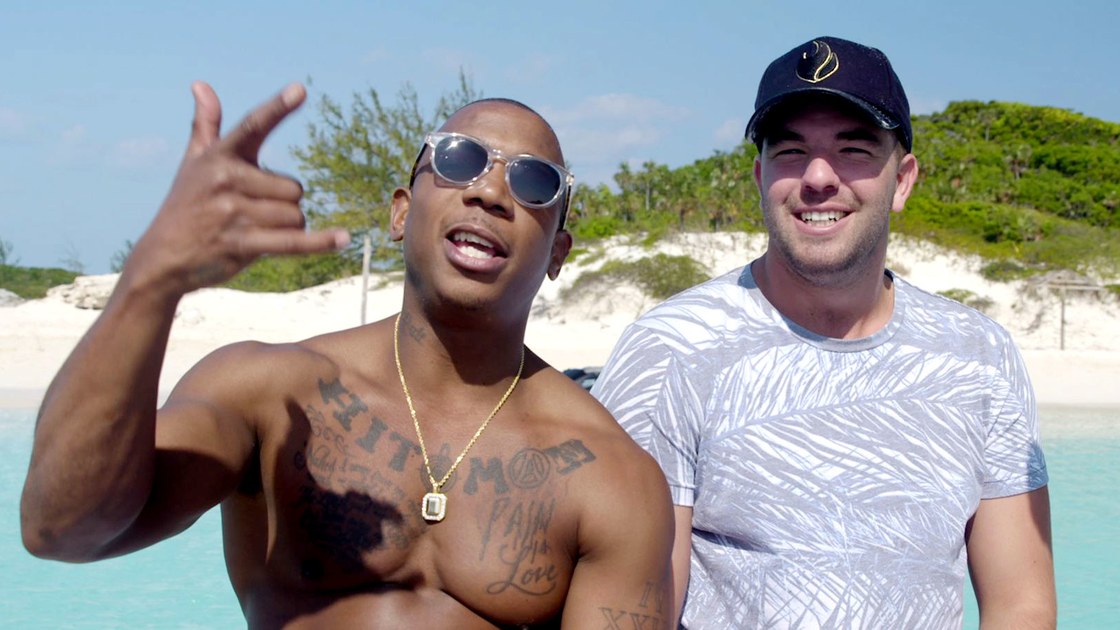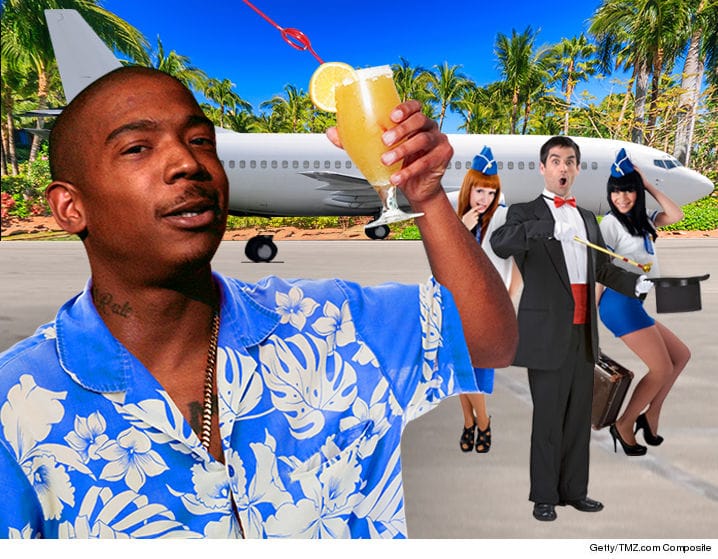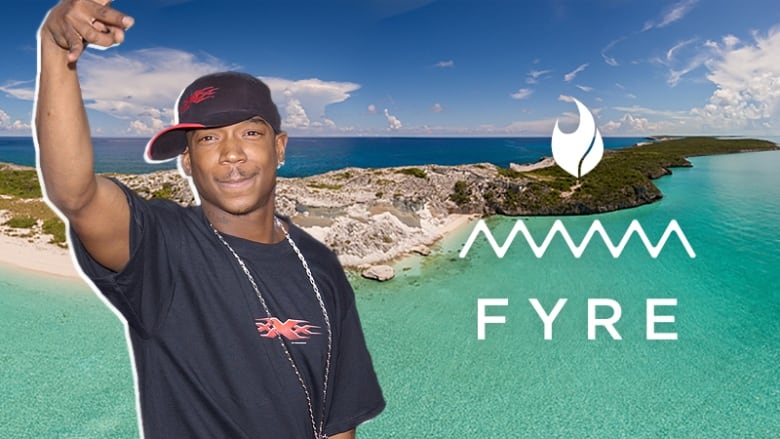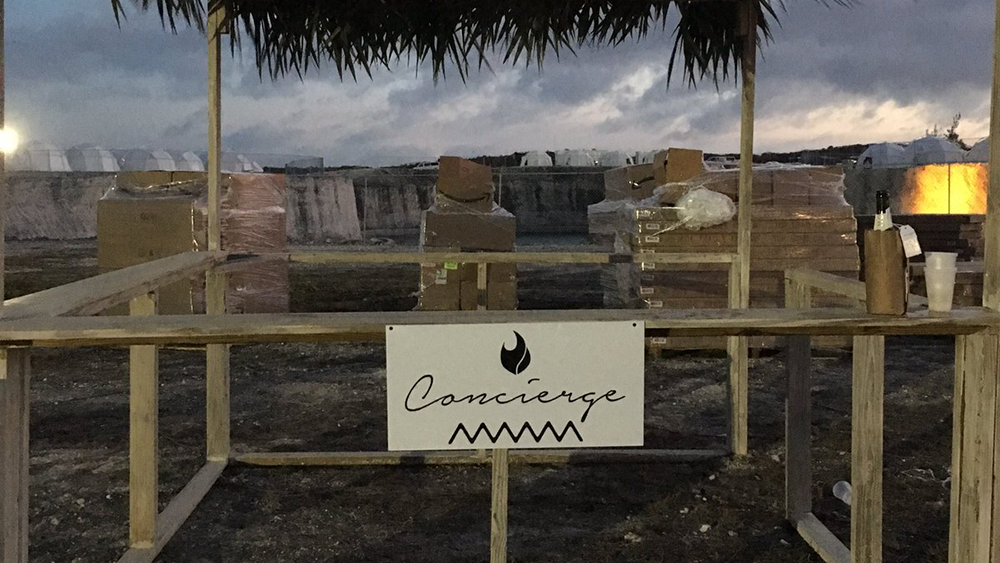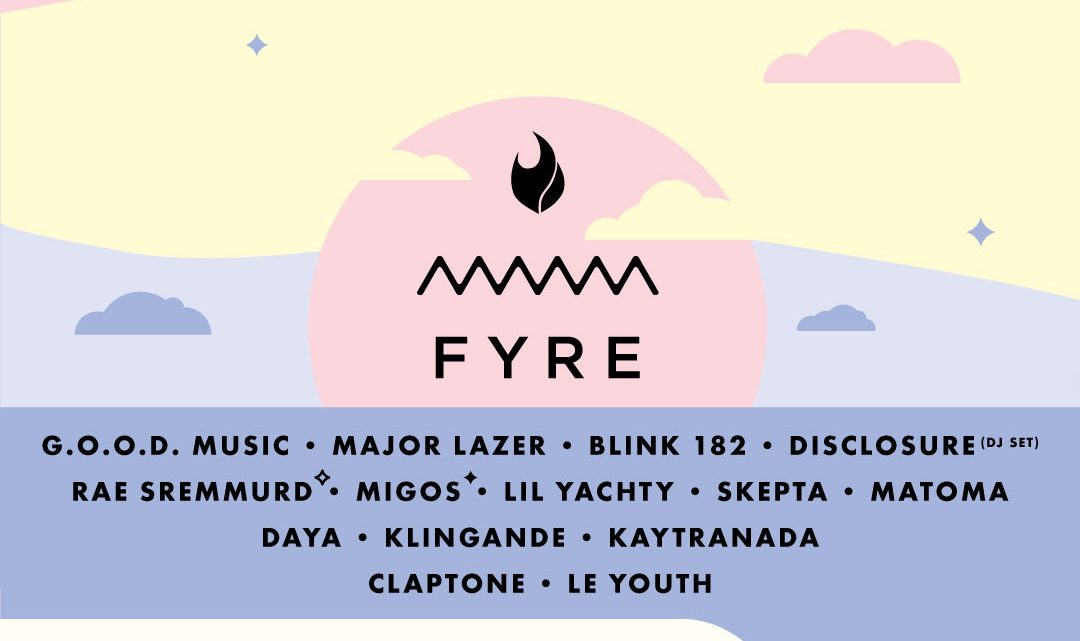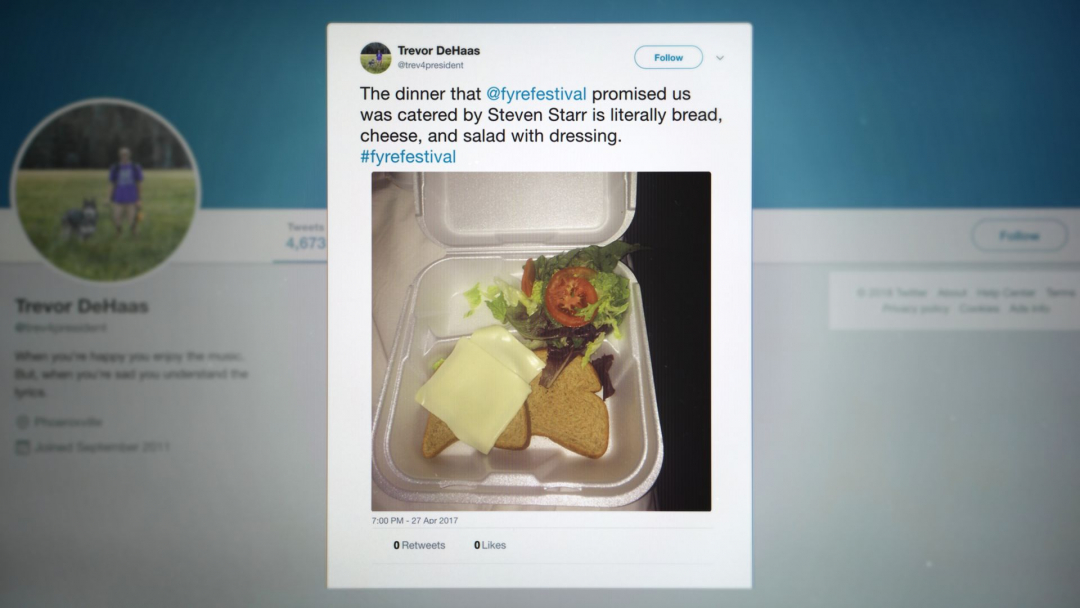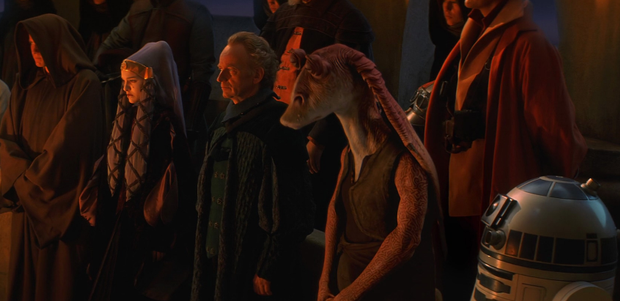The Fyre Festival Epitomizes the Legendary Loserdom Eviscerated in the Joy of Trash: Flaming Garbage Fyre Extended Edition
When the first and final Fyre Festival became a boondoggle of epic proportions it engendered a potent double Schadenfreude among the sizable contingent of the public that takes to social media to delight in the failures of others. Nothing makes online cynics happier than other folks’s misery. The suffering of the Fyre set has made folks positively giddy.
Name a more iconic duo!
(Awkward podcast spiel transition voice) You know what else makes folks positively giddy? Listening to Childproof: The Podcast, the generous sponsor of this here Case File! That’s right! Sponsoring Case Files is totally something that you can do! According to its website, “Childproof is an unproduced TV sitcom written by Tony Martin and Sarina Rowell. The six episodes, starring Tony Martin and Geraldine Quinn, were performed live at the 2017 Melbourne Fringe and then released as a podcast. It concerns those controversial types, the ‘childfree by choice’. They've been called ‘selfish’, ‘immature’, ‘unfulfilled’ and even ‘unAustralian’ – by their own families! Out of step with a world that exalts the traditional family unit above all else, Ian and Jennifer are also battling extinction in their workplaces – commercial radio and book publishing.”
That sounds fascinating to me, especially about the book publishing, an industry whose near-obsolescence I know all too well. And while the Fyre Festival instantly became one of the great disasters of our current millennia Childproof: The Podcast proved a big success, winning Best Comedy Podcast in the 2018 Australian Podcast Awards. That’s right: people apparently read this website all the way in Australia! Now back to the festival:
The public understandably had a difficult time generating sympathy for rich assholes willing to spend fifteen thousand dollars for the privilege of watching Blink 182 perform while on a yacht partying with supermodels and guzzling champagne on a tropical island. Then again, given the cruel nature of online discourse it seems safe to say that the rubberneckers glorying in the ill-fated, poorly named festival’s spectacular demise were more interested in mocking everyone involved than in empathizing with them.
When Fyre went down in flames, Twitter’s snark brigade laughed maliciously in the festival’s direction, Nelson Muntz-style. The unseemly but infectious glee the internet took in the festival’s failure was even more intense and vitriolic when directed at the people who ran the festival, the hucksters who sold a stupid, shallow and superficial public in thrall to the empty glamour of the social media influencer an impossible fantasy of hedonistic excess it could not ultimately deliver.
The Fyre Festival afforded the public yet another opportunity to laugh derisively at Ja Rule.
The 50 Cent nemesis’ central presence at a much-hyped 2017 festival alone should have served as a red flag. After all, you can’t really have a hip, A-list, prestigious new festival with a walking punchline of a has been as your face and voice.
To anyone paying attention, Ja Rule’s presence gave the game away. It betrayed the actual nature of the festival and its behind the scenes players: desperate and D-list, a shoddy simulacrum of money and power and prestige instead of the real thing. Having Ja Rule serve as the soul, mouth and hype of a ritzy music festival would be like trying to re-invent comedy festivals with a prohibitively expensive week-long celebration of stand-up in Joshua Tree with Carlos Mencia as the curator, founder and face.
Now THIS is how you run a music festival
There was a time when Ja Rule was, in fact, one of the most famous and successful rappers alive. Unfortunately for the Fyre Festival, that time was seventeen years ago, in 2002. Billy McFarland, the co-founder of the Fyre Festival, was ten years old then. Consequently, when McFarland was a small, suggestible child, Ja Rule was as big as they came. We have an inherent deference towards people who were famous when we were children. The world might have knocked them down a few pegs but some part of us will always see them the way we did when we were kids, as heroes, idols, Gods, figures of incredible glamour and prestige.
McFarland and Ja Rule completed each other in some weird, horrible, toxic way. Hanging out with Ja Rule and starting a festival together that wouldn’t just be a series of concerts but an immersive, once-in-a-lifetime upscale lifestyle experience afforded the geeky wannabe tech mogul an opportunity to play rock star.
Ja Rule, in turn, who released exactly one album—2012’s Pain is Love 2, which debuted at 197 on the pop charts and sold 3200 copies its first week, a far cry from Rule: 3:36 and Pain is Love, both of which hit number one—between 2004’s R.U.L.E and the Fyre Festival in 2017 saw an opportunity to re-invent himself as an aggressive, ambitious tech entrepreneur primed to make a second gaudy fortune selling the superstar rock and roll lifestyle he rapped about in his glitzy commercial prime to a new generation.
It’s Murdaaaaa……!
The Fyre Festival was notoriously designed for debauched revelers who wanted to live like movie stars, party like rock stars and fuck like porn stars, to paraphrase a quote that figures prominently in the documentaries about the festival’s failure, Hulu’s Fyre Fraud and Netflix’s Fyre: The Greatest Party That Never Happened.
It didn’t quite work out that way. Attendees were undoubtedly too exhausted, terrified, angry and dispirited, not to mention uncomfortable, for even mediocre, uncreative sex but Rule was, undeniably a star. True, he was a star who peaked seventeen years earlier, and had recently spent time in prison for tax evasion when McFarland hooked up with him personally and professionally around 2015 but fame, hype and buzz were the rocket fuel that powered the Fyre festival. When Fyre promised to re-invent the destination festival for a few months in 2017, Rule still possessed the hypnotic, disorienting magic of celebrity, even in degraded form.
That Rule had recently gone to prison for not paying the government money that he owed should have been another red flag for young entrepreneurs wanting to get into the Ja Rule business, the Billy McFarland business or the Ja Rule/Billy McFarland business. After all, if a dude is willing to go to jail rather than give the government the money he is legally, morally and ethically obligated to pay them then he’s probably not going to lose sleep over not paying employees overtime or providing them benefits.
There were so many red flags for the infamous festival that that Fyre might as well have begun with an epic red flag parade although for the purpose of branding (and Fyre was nothing if not a radical experiment in branding gone horribly awry) they should toss in a few flags in the festival’s signature burnt orange shade just to confuse the matter further.
The Fyre Festival reminded the public just how much they enjoyed laughing at Ja Rule. But it also provided villains and sources of mockery and scorn of a more recent, more relevant vintage. The disaster doubles as a scathing indictment of the “influencer” mindset.
The idea of the “influencer” is that there are people so beautiful, so glamorous and so inveterately worthy of envy and jealousy that brands and companies throw money at them to share photographs on Instagram, Twitter and Facebook showcasing their products, goods and services in the best possible light. It’s like modeling only somehow even more superficial, damaging and unhealthy. It’s a way of monetizing envy as well as lust and greed, of making cash money off the public looking at pictures of you on the permanent vacation that constitutes your lush life, and wanting to fuck you, be you, or both.
The Fyre Festival represented the influencer lifestyle in its purest form. Buy a VIP package for the Festival and you wouldn’t just be another nobody on the outside looking in, gazing with envy and lust at Instagram accounts of 20 year olds with perfect bodies and perfect hair, drinking champagne on yachts against a gorgeous tropical sunset. For the right price, you could live that lifestyle for a little bit. You could sneak into the frame and crash that heady world. For thousands upon thousands of dollars you could live the life of an influencer for a weekend or two. You could pay to become one of the beautiful people.
The public’s deep, not unmerited hatred of influencers and the influenced helps explain why people were rooting for the Fyre Festival to fail and then gloried unbecomingly if enjoyably in its demise.
The stupid, stupid dream of the Fyre Festival was that the hottest and most famous super-models in the world (including Kylie Jenner, Bella Hadid and Emily Ratajkowski) were going to be partying on what was once Pablo Escobar’s drug-infested private island, taking in performances from the likes of Major Lazer, Blink 182, the G.O.O.D Music family (which might mean Kanye but more likely meant some protege you’ve never heard of) and Migos while staying in luxury villas and eating gourmet food from the world’s finest chefs and you could party with them in exchange for vast sums of money.
Alternately, they could listen to scheduled performer Li’l Yachty, who I am going to assume from his name is a friendly cartoon yacht who raps about life as a fancy sentient boat, from an actual yacht. Wouldn’t that be a trip? Talk about your off-brand Yacht Rock!
In one of the many depressing aspects of the documentaries and the festival, this cynical ploy worked. The photo sessions with the world’s most expensive models were a huge success. Paying supermodels vast sums to plug the festival was similarly a huge success, particularly since only one did the decent, not to mention legal thing, and acknowledged that she was being paid to do an ad and didn't just find out about Fyre through organic means and took to Instagram to express their genuine excitement about it.
As a photo shoot, Instagram campaign, commercial and outreach program to the sexiest models in the world, Fyre Festival was a smash. That success brought in the money and attention and heat that in turn led to failure on an international, even historic scale.
concierge=fancy!
Deep into the film, a lovely, insanely committed gentleman who earlier said that he would have been willing to perform oral sex on a custom’s guy in exchange for the release of bottled water after McFarland explicitly asks him to do so, argues that people only talk about how wonderful Woodstock was and never about the lack of water, drug overdoses, mud, terrible planning and traffic problems.
That’s not true. All of the hassles and headaches and seemingly unsolvable problems are a huge part of Woodstock’s enduring allure. We don’t celebrate and mythologize Woodstock because it was an amazingly organized festival that ran smoothly and encountered few or no obstacles. No, we have romanticized Woodstock as the spirit of rock and roll and the 1960s counterculture precisely because it was a terribly organized festival that had to overcome incredible obstacles in order to deliver a transcendent musical and spiritual experience for the muddy, drug-addled, clean water-hungry hippies in the crowd and onstage alike.
As someone who worked for two much buzzed-about media companies (Pitchfork and The A.V Club) that threw elaborate music festivals, sometimes in Europe, and has been to the Gathering of the Juggalos six times and spoke at the Juggalo March on Washington I can vouch that uncertainty, doubt and fear of abject failure are a component of every festival, no matter how smoothly run.
I think the fact that Insane Clown Posse, a pair of high school dropouts who perform in clown make-up and spray their fans with cheap soda, manage to successfully pull off an ambitious, involved and high-profile festival of arts and culture every year gives the rest of the festival industry a false sense of confidence. They think that it must be easy, when it is incredibly, almost prohibitively difficult.
Lil Yachty or Noty?
I’ll never forget a Gathering seminar where Violent J and Shaggy 2 Dope talked, with perhaps excessive candor, about how the port-a-potty industry refusing to work with Psychopathic Records nearly kept that year’s Gathering from happening before an unsung hero stepped in and did’s God’s work by renting the clowns shitters for their big yearly celebration.
That speaks to the precariousness of the whole industry: an absence of port-a-potties nearly kept the 2017 Gathering of the Juggalos from happening. The Fyre frauds lacked pretty much everything, not just places for people to relieve themselves.
Fyre Festival co-founders Billy McFarland and Ja Rule made a series of crucial mistakes that, individually and collectively, ensured the kind of failure that people remember forever, that sets the gold standard/nadir for music industry fiascoes. Yet the festival’s founders still refused to cancel under the insane delusion that they still might be able to carry it off if luck was on their side and the universe played ball.
New festivals generally require a year to eighteen months of careful, cautious, very diligent planning to handle the enormous amount of work and preparation involved in throwing a large-scale operation of that nature. The Einsteins over at Fyre decided they could do it in six months. In an equally bone-headed move, they planned the festival during the busiest time of the year for the island they were befouling with their presence, a hugely important regatta that was the boating equivalent of Super Bowl Sunday. That ensured that resources would be scarce but also exceedingly expensive.
The Fyre Festival planners could have made things easier and more palatable and professional for everyone involved by partnering with an outside firm with extensive experience throwing music festivals. Alternately, they could have thrown the festival somewhere with a strong infrastructure capable of handling an influx of partiers needing airfare and accommodations and food and alcohol and water and something approximating order.
Instead, Fyre decided that with their complete lack of relevant experience and time, they were ultimately better suited to handling everything themselves even when reasonable adults who knew what they were talking about told them that what they envisioned was impossible, particularly in the timeframe envisioned.
There’s an element of magical thinking at play as well in the Fyre folks’ belief that they could achieve as complete novices what veterans told them couldn’t be done. People working 18 hour days convinced themselves that with enough hard work, and luck, and money, and star-power they could make a toxic hoax a reality. Everyone was so ferociously focussed on trying to make the impossible happen in a high-stakes, unforgiving environment that they didn’t allow themselves to take a step back and ask big, troubling questions with even bigger, even more troubling answers. These are questions like, “Is Billy McFarland a liar and a con man?”, “Is it even possible to throw any kind of a festival, no matter how disappointing or disastrous, with this particular set of variables at play?”, “Am I working for a criminal operation?” and “Are the people at the top of the organization criminals and sociopaths?”
But they had jet-skis! Do bad people ever have access to jet-skis?
The documentaries devolve into The Hunger Games/Lord of the Flies territory once the unlucky festival-goers discover that a recent monsoon has thrown the already chaotic would-be festival into further disrepair, as horrified big shots discovered that the luxury villas they had paid for were actually FEMA tents and the gourmet food they were promised was actually the kind of barely edible grub you might find in a convenience store in a rundown neighborhood or in a vending machine.
The Fyre Festival paid the shitty people over at FuckJerry, a meme factory turned digital marketing company a lot of money to come up with striking iconography for the festival, imagery that would be “sticky” to put things in Malcolm Gladwell terms. They succeeded in the form of the burnt orange Fyre tile that did so well on Instagram and the commercial with all the supermodels.
But when people think of the festival in the years and decades ahead, they won’t think of Kylie Jenner under a crystal blue sky but rather the apocalyptic image of FEMA tents in a stormy hellscape or, more likely, a cheese sandwich and salad that will live forever in infamy as an unforgettable visual representation of the vast, hilarious gulf between the paradise festival-goers were promised and the unfortunate reality they encountered on the ground.
The picture of that awful, awful sandwich should hang in a goddamn art museum. Like many other elements of the Fyre Festival, it succeeded spectacularly as an oddball piece of performance and pop art precisely because every other aspect of the debacle was such a spectacular, seemingly avoidable failure.
Actually, it would be an insult to the noble cheese sandwich to call what went viral as an all-too-representative example of Fyre Festival cuisine a cheese sandwich. It would be equally wrong to call what accompanied that sad combination of generic bread and overly processed cheese a “salad” instead a horrifying bit of lettuce and mushy tomatoes topped off with a rancid squirt of something that could very charitably be called salad dressing.
The mortified and ripped off festival-goers revolted and instantly changed the narrative from one of glamour and luxury to one of pitch-black dark comedy. Instead of the next Coachella, the Fyre Festival was received as a riotous joke at the expense of Millennials, social influencers, tech bros and Ja Rule the world can’t stop laughing at. These decadent millennials were going to live like the richest of the rich. Instead, they ended up getting a little taste of what life is like for people in poor countries outside the United States for about a day or so, and it sent them screaming in terror with an anecdote they’d be able to eat out on for the rest of their lives. I can only imagine how bored these folks poor kids will be every time they hear their parents brightly volunteer, when/if the occasion demands it, “You know, we were actually AT the Fyre Festival, if you can believe it, and let me tell you…”
Of the two Fyre Festival documentaries everyone is talking about, I vastly prefer Fyre because it understands that a story this bleakly hilarious and utterly compelling doesn’t need to be jazzed up with in-your-face style and attitude to be spectacularly entertaining. We don’t need to watch McFarland’s tragicomic machinations from a delightfully skewed, pop culture-crazy perspective for it to be utterly fucking fascinating and uncomfortably hilarious. You don’t need to dress up this story in a professor’s tweed jacket and have it bloviate about what the festival’s failure says about society and social media, and influencer culture, and millennials, and their disillusionment with the cultural and consumerist trappings of the generations that came before them.
The more Fyre Fraud tries to be deep and profound, to be about so much more than just a silly music festival that didn’t happen, the shallower and more superficial it seems. The more if frames the festival’s rise and fall through an aggressively generational lens, the hollower its ideas become. If it wants to provide food for thought, it’s nothing more than a light snack.
You save money by only going to one of the weekends!
I also was really annoyed by Fyre Fraud’s use of clips from generational touchstones like The Simpsons and Seinfeld to comment satirically on the action. It was incredibly distracting. Instead of drawing meaningful parallels between the entertainment millennials consume and their aspirations and sense of self I just felt like I was watching Dream On.
And what of Ja Rule? Ja Rule emerges as an oddly slippery figure here. When it’s time to party with supermodels and toast to living like movie stars, partying like rock stars and fucking like porn stars, he’s front and center with that big, cheesy superstar grin but when it came time for accountability, he was nowhere to be found, or rather, he chose to point the finger instead at McFarland and present himself as yet another victim of his now-imprisoned co-founder’s devilish ways.
Rule’s defense seems to be that he came up with the idea for an exclusive festival on an exotic island with attractions like a million-treasure dollar hunt (oh, but the crazy, wonderful details never end!) and, being an artist and a musician rather than a businessman, entrusted the day-to-day details to McFarland, and was mortified and disappointed to discover that his partner was a con man and a fraud rather than an upstanding businessman as he previously believed.
That is, of course, bullshit even if I can’t imagine Rule staying up late at night going over the ledgers with McFarland. Of course Ja knew. But it also seems possible, even plausible, that Ja didn’t want to know what was actually going on behind the scenes for the sake of Plausible deniability and that McFarland would not be eager to share information with his ostensible partner that might make him look bad, or criminal, or like a fraud. Nevertheless, it does not reflect well upon Rule that he now is involved with a company called Iconn, as in “Iconned a lot of people with the Fyre Festival and app, and I’ll con even more this time around.”
Ja Rule has buzz now. The streets are talking about him, as are the suburbs but for even more embarrassing reasons now than when 50 Cent was making him the laughingstock of Hip Hop with classic diss tracks like “Wanksta” and “Back Down.”
Watching the dueling documentaries on the Influencer Altamont that was the Fyre Festival, a strange, seemingly counter-intuitive thought struck me. I couldn’t help but notice that, just like Ja Rule, Fyre has incredible heat right now. It has incredible buzz. It has incredible name recognition. It’s no exaggeration to say that people can’t stop talking about the Fyre Festival, that it’s enjoying a huge cultural moment after its initial huge cultural moment back in 2017. Hell, as I write this, Billy McFarland is trending on Twitter.
True, all of the Fyre Festival’s buzz is negative. People are talking about what a once-in-a-lifetime shit show McFarland and Rule’s epic folly was and marveling at how something like that could possibly have happened. But infamy is the flip side of fame and Billy McFarland is real fucking famous as well as infamous right now, as is his universally mocked brainchild, even if the context is that the whole world is laughing at them and glorying in their spectacular and surreal and wildly entertaining and juicy failure.
Something tells me we haven’t seen the last of McFarland or Fyre. The legend of the Fyre Festival is simply too stupid and too famous for it to stay dead forever. At the very least, it merits a proper narrative Hollywood movie or Serial-style true crime podcast or Netflix mini-series. Who would you cast in the plum roles of Billy McFarland and Ja Rule?
Ja Rule+Ja Jar=It’s Murda!!!!!!!!
I would watch the fuck out of Spring Breakers 2: The Fyre Festival Heist or a reality show starring Ja Rule about his experiences post-prison and post-Fyre Festival entitled After the Fyre, After the Reign. Best of all, we could turn a massive negative into a positive by ensuring that every dollar made from Fyre Festival-related projects went directly to the Bahamian workers fucked over by the festival instead of the charlatans and ne’er do wells behind it.
Did you enjoy this article? Then you will LOVE the Flaming Garbage Fire Edition of The Joy of Trash because it includes this piece and 51 more just like it!
Buy The Joy of Trash: Flaming Garbage Fire Extended Edition at https://www.nathanrabin.com/shop and get a free, signed "Weird Al” Yankovic-themed coloring book for free! Just 18.75, shipping and taxes included! Or, for just 25 dollars, you can get a hardcover “Joy of Positivity 2: The New Batch” edition signed (by Felipe and myself) and numbered (to 50) copy with a hand-written recommendation from me within its pages. It’s truly a one-of-a-kind collectible!
Or you can buy The Joy of Trash from Amazon at https://www.amazon.com/Joy-Trash-Nathan-Definitive-Everything/dp/B09NR9NTB4/ref=tmm_pap_swatch_0?_encoding=UTF8&qid=&sr= but why would you want to do that?
Check out my new Substack at https://nathanrabin.substack.com/
And we would love it if you would pledge to the site’s Patreon as well. https://www.patreon.com/nathanrabinshappyplace



